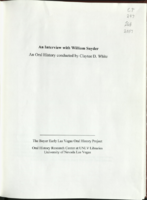Search the Special Collections and Archives Portal
Search Results

Transcript of interview with Bill Snyder by Claytee White, November 21, 2008
Date
Archival Collection
Description
In 1978 Bill Snyder came Las Vegas for a heavyweight championship fight between his homeboy, Larry Holmes and Ken Norton. During that visit, he saw cranes dotting the cityscape so he returned home and proposed that the family move across country and settle in the desert. His wife, Joy, gave him a year. And as they say, the rest is history. And what am amazing history it is. In this interview, Bill Snyder talks about his life from its beginning in Easton, Pennsylvania, where he discovered the challenge of architecture first by perusing books in the library and then by hands-on construction experience. But his love of art built the foundation to this treasured craft that has allowed him to design homes, office buildings, airport terminals and the McCaw School of Mines on the campus of McCaw Elementary School in Henderson, NV. The projects that Mr. Snyder seems to prize most are those that include the imagination of children. The people who shaped his life are introduced and the impact of his military training is wonderfully expressed. His connection with young people is paramount throughout the oral history that is beautifully documented with images of many of the projects that displayed children's art in an exciting way. Bill and Joy are the parents of two sons. Dana age 36, lives with his wife Christine in Hollywood, California, and works as a voice actor best known for his role as Master Shake on the cartoon Aqua Teen Hunger Force. Their younger son, Mike age 31, owns The Krate, a clothing, music, and art shop in Santa Cruz, California, where he lives with his wife Mandy and daughter Maya. A husband, father, sports car enthusiast, runner, thinker and lover of teaching and trusting young people, Bill Snyder is a brilliant architect and manager of people. He is dyslectic and never expected a school to be named in his honor but the William E. Snyder Elementary School was dedicated in 2001 with overwhelming community support. One of his current goals is to dream an architectural project that rivals the McCaw School of Mines for his own school. I trust that you will learn to love architecture in a different and very profound way as you read this interview just as I did during my conversation with Bill.
Text
Edward Vance oral history interview
Identifier
Abstract
Oral history interview with Edward Vance conducted by Stefani Evans and Claytee D. White on September 16, 2016 for the Building Las Vegas Oral History Project. In this interview, Vance discusses his upbringing in Redfield, South Dakota. He talks about his move to Las Vegas, Nevada in 1987, teaching architectural drawing at the University of Nevada, Las Vegas (UNLV), and the first projects he worked on in Las Vegas. Vance describes the financial aspects of architecture, the challenges of meeting building regulations, and benefits that new buildings bring to city life. Lastly, Vance discusses founding Ed Vance & Associates Architects.
Archival Collection
Melvin Green oral history interview
Identifier
Abstract
Oral history interview with Melvin Green conducted by Stefani Evans and Claytee D. White on September 23, 2016 for the Building Las Vegas Oral History Project. In this interview, Green discusses his upbringing in Louisiana and growing up in a family of farmers. He recalls moving to Las Vegas, Nevada in 1983, working for Nevada Partners, and his involvement in the redevelopment of the Westside School. Green talks about his architect firm, KME Architects, and lists projects his company has worked on in Las Vegas. Lastly, Green describes presenting new designs to community members and partnering with church leaders to build community housing.
Archival Collection
John Klai II oral history interview
Identifier
Abstract
Oral history interview with John Klai II conducted by Stefani Evans and Claytee D. White on August 15, 2016 for the Building Las Vegas Oral History Project. In this interview, Klai discusses his upbringing in North Dakota. He recalls attending the University of North Dakota and transferring to North Dakota State University to study architecture. Klai talks about moving to Las Vegas, Nevada in the late 1970s, and his employment at Marnell Corrao Associates. Klai describes founding an architecture firm, Klai Juba Wald Architects + Interiors in 1995, and talks about the firms involvement with the architecture program at the University of Nevada, Las Vegas (UNLV). Lastly, Klai discusses sponsoring a lecture series at UNLV, and awarding scholarships to UNLV architecture students.
Archival Collection
Harry Hayden Whiteley Architectural Records
Identifier
Abstract
The Harry Hayden Whiteley Architectural Records are comprised of architectural records (1931-1970) created and/or maintained by the American architect Harry Hayden Whiteley and/or his architectural firm, known as Harry Hayden Whiteley and Associates. This collection includes 30.21 linear feet of materials including 45 items from over 30 projects. The collection focuses on his work in the Las Vegas and Reno, Nevada areas. The materials feature both architectural drawings and project files. Architectural drawings include pencil and ink on tracing paper preliminary sketches and mounted artist’s renderings used for presentations and promotional materials. Project files include project correspondence, photographs, and structural calculations. The drawings also contain work from the architect Paul Revere Williams. The collection includes architectural drawings for hotels, shopping plazas, residential developments, and office buildings.
Archival Collection
Steven Kwon oral history interview
Identifier
Abstract
Oral history interview with Steven Kwon conducted by Stefani Evans on October 1, 2024 for the Reflections: the Las Vegas Asian American and Pacific Islander Oral History Project. In this interview, Kwon begins by describing his childhood in Seoul, Korea as the youngest of three children during the Korean conflict. In 1960, he served his compulsory military service, which was 18 months for students. In 1964, he followed a friend's recommendation to go to Denmark and attend the folk high school (now the International People's College) to immerse himself in the Danish language, history, and community. He spent one year at the folk high school and later attended the College of Building Technology at the University of Denmark. While he was in his final year, Las Vegas, Nevada architect James McDaniel recruited him to join his firm, which he did in December 1974. After working with McDaniel for one year, he joined Jack Miller Associates for three years and David Welles/Architronics before opening his own design/build firm, GKG Builders in 1986, which he claims was the first Las Vegas firm to offer both services. Soon after arriving in Las Vegas, he joined the Lions Club and Rotary International and, in 1986 created Southern Nevada's first Asian Chamber of Commerce. He also worked with various politicians at different levels of government to encourage South Korean investment in Las Vegas and Nevada, eventually forming a sister-city relationship between Las Vegas, Nevada, and An San, Korea. Lastly, Kwon recalls how he came to design and build the International Peace Education Center (IPEC) on Bermuda Road for the Reverend Sun Myung Moon, founder of the Unification Church, shortly before Moon passed away.
Archival Collection
Harry Hayden Whiteley Photograph Collection
Identifier
Abstract
The Harry Hayden Whiteley Photograph Collection (approximately 1940-1967) contains photographic prints and one photographic negative depicting buildings, people, and project locations associated with the Las Vegas, Nevada architect Harry Hayden Whiteley. There is also one album containing photographs of contemporary churches compiled by Whiteley between 1953 to 1958.
Archival Collection
Walter Zick oral history interview
Identifier
Abstract
Oral history interview with Walter Zick conducted by Maureen Kelly Ryan on February 22, 1977 for the Ralph Roske Oral History Project on Early Las Vegas. Zick discusses architecture and moving to Las Vegas, Nevada to work at the Basic Magnesium Plant.
Archival Collection
Judy and Harry Campbell oral history interview
Identifier
Abstract
Oral history interview with Judy and Harry Campbell conducted by Stefani Evans and Claytee D. White on October 04, 2016 for the Building Las Vegas Oral History Project. In this interview, Judy discusses her early life in St. John’s, Newfoundland and her move to Ottawa, Canada. Harry discusses his upbringing in Ogden, Utah and his initial interests in architecture. He recalls moving to Las Vegas, Nevada to work for architect Julius Gabriel, construction planning for the Four Queens, and planning for the home of Jerry Mack. Later, Judy talks about her move to Boulder City, Nevada in 1974, her involvement in interior design, and her initial interests in residential real estate. Later, Harry recalls his work with the construction planning of federal court rooms, working with Las Vegas architects, and the process of becoming a licensed architect. Lastly, Judy and Harry talk about the development of Lake Las Vegas.
Archival Collection

Transcript of interview with Joel Bergman by Stefani Evans and Claytee D. White, August 03, 2016
Date
Archival Collection
Description
Born in 1936, architect Joel Bergman spent his childhood in Venice, California, the son of Edythe Klein and Harry Bergman, a baker who later turned to dealing in scrap metal. The award-winning designer of such Las Vegas projects as the International Hotel, the MGM Grand Hotel (later Bally's), additions to the Riviera Hotel and the Golden Nugget downtown, the Mirage, Treasure Island, Paris Casino Resort, Caesars Palace, Trump International Hotel and Tower, the Signature at MGM Grand, Rhumbar, Gilley's at Treasure Island, and the Tropicana Hotel and Casino first arrived in Las Vegas in 1968 to work on the International Hotel. In this interview, Bergman discusses his architectural career, which began with his graduation in architecture from the University of Southern California; he also discusses his work with Martin Stern, his sixteen years with Steve Wynn, and the formation of his own architectural firm, Bergman Walls and Associates. Throughout, he pays tribute to the three mentors who had the greatest influence on his work—USC architecture professor Carleton Winslow, architect Berton Severson, and client Steve Wynn—and the ways they visualized people moving through space. He acknowledges other professionals whose work he admired and talks about his wives Marlene Federman, Terrie Colston, Maria Nicolini, and Valentina Bogdanova as well as his children and stepchildren. Joel David Bergman passed away August 24, 2016, three weeks after he gave this interview.
Text
